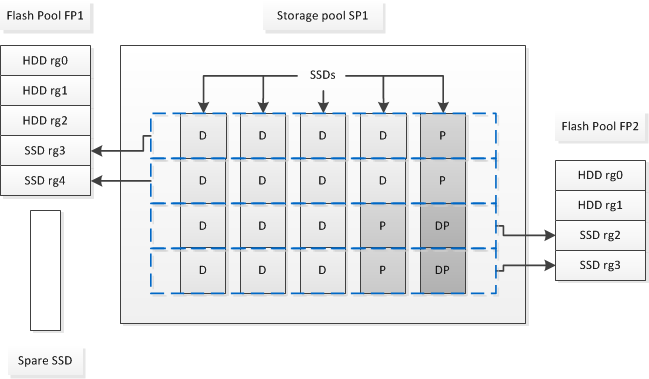How Flash Pool SSD partitioning works for Flash Pool aggregates using storage pools
If you are providing cache to two or more Flash Pool aggregates, you should use Flash Pool Solid-State Drive (SSD) partitioning. Flash Pool SSD partitioning allows SSDs to be shared by all the aggregates using the Flash Pool. This spreads the cost of parity over multiple aggregates, increases SSD cache allocation flexibility, and maximizes SSD performance.
For an SSD to be used in a Flash Pool aggregate, the SSD must be placed in a storage pool. You cannot use SSDs that have been partitioned for root-data partitioning in a storage pool. After the SSD is placed in the storage pool, the SSD can no longer be managed as a stand-alone disk and cannot be removed from the storage pool unless you destroy the aggregates associated with the Flash Pool and you destroy the storage pool.
SSD storage pools are divided into four equal allocation units. SSDs added to the storage pool are divided into four partitions and one partition is assigned to each of the four allocation units. The SSDs in the storage pool must be owned by the same HA pair. By default, two allocation units are assigned to each node in the HA pair. Allocation units must be owned by the node that owns the aggregate it is serving. If more Flash cache is required for aggregates on one of the nodes, the default number of allocation units can be shifted to decrease the number on one node and increase the number on the partner node.
You can use only one spare SSD for a storage pool. If the storage pool provides allocation units to Flash Pool aggregates owned by both nodes in the HA pair, then the spare SSD can be owned by either node. However, if the storage pool provides allocation units only to Flash Pool aggregates owned by one of the nodes in the HA pair, then the SSD spare must be owned by that same node.
The following illustration is an example of Flash Pool SSD partitioning. The SSD storage pool provides cache to two Flash Pool aggregates:

Storage pool SP1 is composed of five SSDs and a hot spare SSD. Two of the storage pool's allocation units are allocated to Flash Pool FP1, and two are allocated to Flash Pool FP2. FP1 has a cache RAID type of RAID4. Therefore, the allocation units provided to FP1 contain only one partition designated for parity. FP2 has a cache RAID type of RAID-DP. Therefore, the allocation units provided to FP2 include a parity partition and a double-parity partition.
In this example, two allocation units are allocated to each Flash Pool aggregate. However, if one Flash Pool aggregate required a larger cache, you could allocate three of the allocation units to that Flash Pool aggregate, and only one to the other.